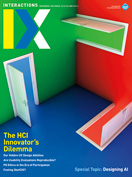Authors:
Chang Lee, Dan Lockton, David Verweij, Dave Kirk, Kay Rogage, Abigail Durrant, Aubree Ball, Audrey Desjardins, Adam Horowitz, Ishaan Grover, Pedro Reynolds-Cuéllar, Oscar Rosello, Tomás Vega, Abhinandan Jain, Cynthia Breazeal, Pattie Maes
The aim of this project was to tangibly study a playful experience that would occur without any direct physical or sensory interaction. Silent Scene is an unusual machine that does not offer any interactions to anyone. It is a stationary device that appears to do nothing. However, when there are no humans in its environment—when no sound, motion, or light is detected—it secretly starts to create beams and rays of stunning colors. The device will not function if anyone is near it, which, for some people, is a kind of playful experience.
Lee, C.H., Lockton, D., and Kim, J.E. Exploring cognitive playfulness through zero interactions. Proc. of the 2018 ACM Conference Companion Publication on Designing Interactive Systems. ACM, New York, 2018.
https://www.changheelee.com/silent-scene.html
Chang Hee Lee, Royal College of Art
[email protected]
Dan Lockton, Carnegie Mellon University
[email protected]
 |
When no one is around, Silent Scene comes to life, emitting rays of colors. |
 |
Silent Scene lies dormant when humans are present. |
With the aim of co-creating the future Internet of Things with families, we are developing open, data-enabled physical visualizations called Domestic Widgets. Starting with a do-it-together cardboard kit, families can assemble and are encouraged to decorate and complete the unfinished designs using everyday materials they have lying around. Through speech-based interaction, the Widgets aim to lower the "programming threshold" for family members of all ages and with any level of technical proficiency. This approach also leverages the discoverability and transparency of speech interaction, further motivating collaborative creation and reuse of the data-enabled artifacts.
David Verweij, David Kirk, Kay Rogage, and Abigail Durrant, Northumbria University
[email protected]
 |
The pre-programmed microcontrollers allow nearly screenless setup and control using the Google Home (Mini), focusing on hands-free, quick, and easy alteration of a Widget's functionality. |
 3. Dwelling Amongst a Ludic Internet of Things
3. Dwelling Amongst a Ludic Internet of Things
These two bespoke systems were designed for my family and our unique home. They aim to broaden mainstream visions of home IoT objects through an autobiographical design inquiry. The Thought Projectors offer an ambient way to communicate non-urgent thoughts, curiosities, past-experiences, and simple pleasures. With a single switch, they play a collaborative YouTube playlist. Videos are added to the playlist remotely via YouTube's mobile interface. The Inter(net) coms are a wireless network of rebuilt home intercoms, originally installed in the home in 1974. Using a VoIP application and a private server, they function like a chat room throughout the house, offering a convivial convenience.
Desjardins, A. and Ball A. Revealing tensions in autobiographical design in HCI. Proc. of the 2018 Designing Interactive Systems Conference. ACM, New York, 2018.
http://depts.washington.edu/soagrd18/project/aubree-ball/
Aubree Ball, University of Washington
[email protected]
Audrey Desjardins, University of Washington
[email protected]
 |
Thought Projectors offer an ambient way to communicate non-urgent thoughts, curiosities, past-experiences, and simple pleasures. |
 |
Inter(net)coms, a wireless network of rebuilt home intercoms, function like a chat room throughout the house. |
 |
Aubree Ball's daughter uploading a video to the Thought Projectors playlist. |
Sleep is a forgotten country of the mind.
Sleep is a forgotten country of the mind: A vast majority of our technologies are built for our waking state, even though a third of our lives are spent asleep. Dormio interfaces with hypnagogia, the state of consciousness between wakefulness and sleep in which we dream before falling fully unconscious. Dormio allows users to track and interrupt specific sleep-stage transitions with dream suggestions, modernizing the steel-ball napping technique used by Edison, Dalí, and Tesla to generate creative insights. Dormio enables the extension, inception, and capture of dream content, allowing access to fluid thinking present in interstitial semi-consciousness and dreams.
Haar Horowitz, A. et al. Dormio: Interfacing with dreams.
Extended Abstracts of the 2018 CHI Conference on Human Factors in Computing Systems. ACM, New York, 2018.
https://www.media.mit.edu/projects/sleep-creativity/overview/
https://www.youtube.com/watch?v=joYEbU2R57Q
Adam Haar Horowitz, Ishaan Grover, Pedro Reynolds-Cuéllar, Oscar Rosello, Tomás Vega, Abhinandan Jain, Cynthia Breazeal, and Pattie Maes, MIT Media Lab
[email protected]
 |
Dormio interfaces with hypnagogia, the state between wakefulness and sleep. |
©2018 ACM 1072-5520/18/11 $15.00
Permission to make digital or hard copies of all or part of this work for personal or classroom use is granted without fee provided that copies are not made or distributed for profit or commercial advantage and that copies bear this notice and the full citation on the first page. To copy otherwise, to republish, to post on servers or to redistribute to lists, requires prior specific permission and/or a fee.
The Digital Library is published by the Association for Computing Machinery. Copyright © 2018 ACM, Inc.







Post Comment
No Comments Found